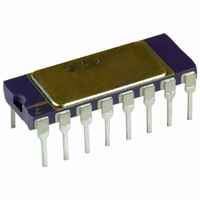AD625AD Analog Devices Inc, AD625AD Datasheet

AD625AD
Specifications of AD625AD
Available stocks
Related parts for AD625AD
AD625AD Summary of contents
Page 1
PRODUCT DESCRIPTION The AD625 is a precision instrumentation amplifier specifically designed to fulfill two major areas of application: 1) Circuits re- quiring nonstandard gains (i.e., gains not easily achievable with devices such as the AD524 and AD624). 2) ...
Page 2
AD625–SPECIFICATIONS Model GAIN Gain Equation Gain Range 1 Gain Error Nonlinearity, Gain = 1-256 Gain>256 1 Gain vs. Temp. Gain<1000 GAIN SENSE INPUT Gain Sense Current vs. Temperature Gain Sense Offset Current vs. Temperature VOLTAGE OFFSET (May be Nulled) Input ...
Page 3
Model Min NOISE Voltage Noise, 1 kHz R.T.I. R.T.O. R.T.I., 0 100 G = 1000 Current Noise 0 SENSE INPUT ...
Page 4
... Differential Input Voltage . . . . . . . . . . . . . . . . . . . . . . . . . ± V Output Short Circuit Duration . . . . . . . . . . . . . . . . Indefinite Storage Temperature Range ( –65°C to +150°C Storage Temperature Range ( –65°C to +125°C Model Temperature Range AD625AD –40°C to +85°C AD625BD –40°C to +85°C AD625BD/+ –40°C to +85°C AD625CD – ...
Page 5
SUPPLY VOLTAGE – V –160 –140 G = 1000 G = 100 –120 –100 –80 –60 –40 – 100 ...
Page 6
AD625 –10 –20 –30 –40 –125 –75 – 125 TEMPERATURE – C 8.0 6.0 4.0 2 SUPPLY VOLTAGE – OUT AD625 10V –V ...
Page 7
– 1000 G = 100 – OUTPUT STEP – – 100 G = 1000 8 TO – –12 ...
Page 8
AD625 THEORY OF OPERATION The AD625 is a monolithic instrumentation amplifier based on a modification of the classic three-op-amp approach. Monolithic construction and laser-wafer-trimming allow the tight matching and tracking of circuit components. This insures the high level of performance ...
Page 9
Any resistors in series with the inputs of the AD625 will degrade the noise performance. For this reason the circuit in Figure 26b should be used if the gains are all greater than 5. For gains less than 5, either ...
Page 10
AD625 the I × R drops “inside the loop” and virtually eliminating this error source. Typically, IC instrumentation amplifiers are rated for a full ± 10 volt output swing into 2 kΩ. In some applications, however, the need exists to ...
Page 11
Offset voltage and offset voltage drift each have two compo- nents: input and output. Input offset is that component of offset that is generated at the input stage. Measured at the output it is directly proportional to gain, i.e., input ...
Page 12
AD625 GROUND RETURNS FOR BIAS CURRENTS Input bias currents are those currents necessary to bias the input transistors amplifier. There must be a direct return path for these currents, otherwise they will charge external capaci- tances, causing ...
Page 13
These capacitances may also be incorporated as part of the external input protection circuit (see section on Input Protec- tion general practice every effort should be made to match the extraneous capacitance at Pins 15 and 2, and ...
Page 14
AD625 1000 800 400 R 200 100 500 GAIN DETERMINING SPGA RESISTOR NETWORK VALUES The individual resistors in the gain network can be calculated sequentially ...
Page 15
Plastic DIP (N-16) 0.755 (19.18) 0.745 (18.93 0.26 (6.61) 0.24 (6. 0.306 (7.78) PIN 1 0.294 (7.47) 0.17 (4.32) MAX 0.175 (4.45) SEATING 0.12 (3.05) PLANE 0.02 (0.508) 0.015 (2.67) 0.065 (1.66) 0.015 (0.381) 0.095 ...













